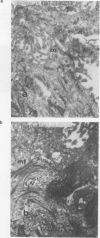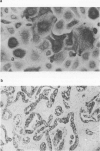Abstract
A new cell line (CAL51) was isolated from a malignant pleural effusion of a woman with metastatic breast cancer. These cells grow in continuous culture and exhibit the morphological, ultrastructural and immunohistochemical features of epithelial cells of mammary origin. They are tumorigenic in nude mice and clone in soft agar. Oestrogen receptors are not detected. CAL51 consists of a homogeneous population of cells with normal chromosomes even after the use of high resolution banding. Cytogenetic analysis of the cells from the tumour induced by CAL51 in the nude mouse confirmed the normality and the stability of the karyotype. All breast cancer cell lines established to date present abnormal karyotypes; CAL51 cell line may be more informative than cell lines with aberrant karyotypes for investigating essential genetic differences between normal and malignant mammary gland cells.
Full text
PDF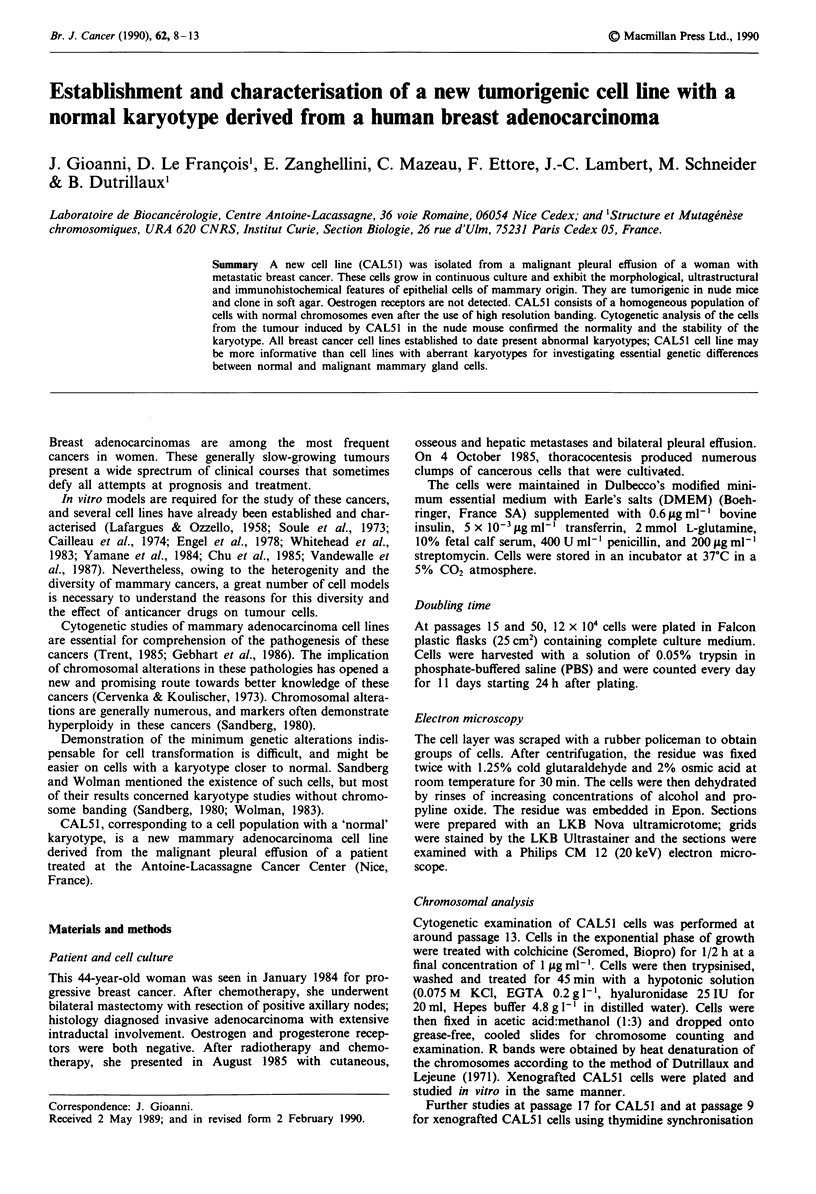
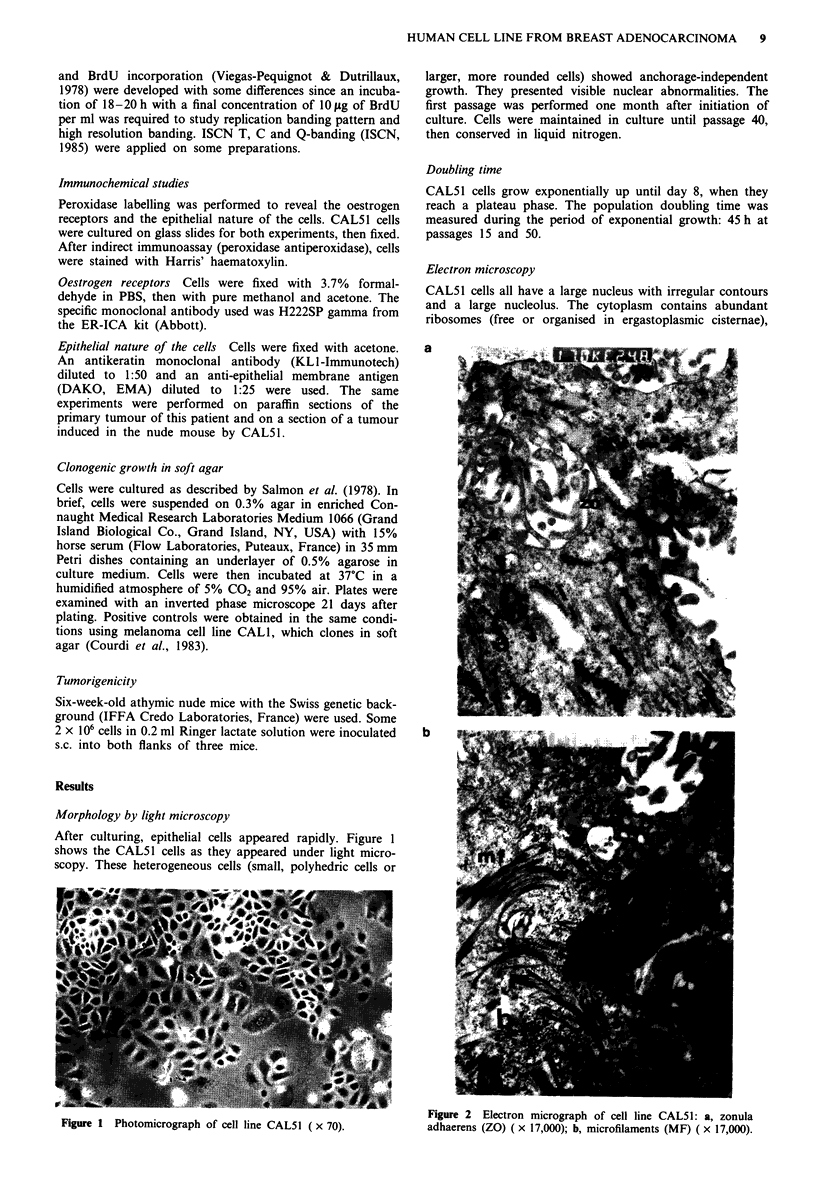
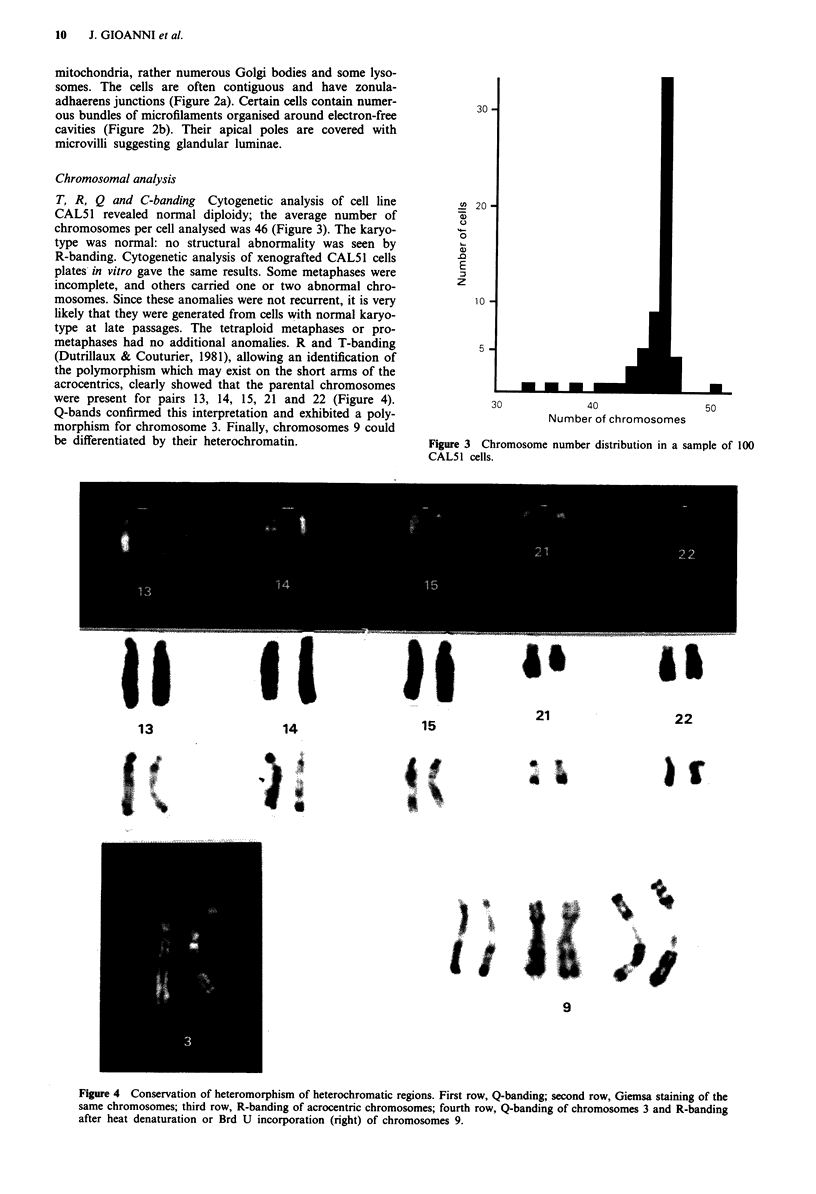
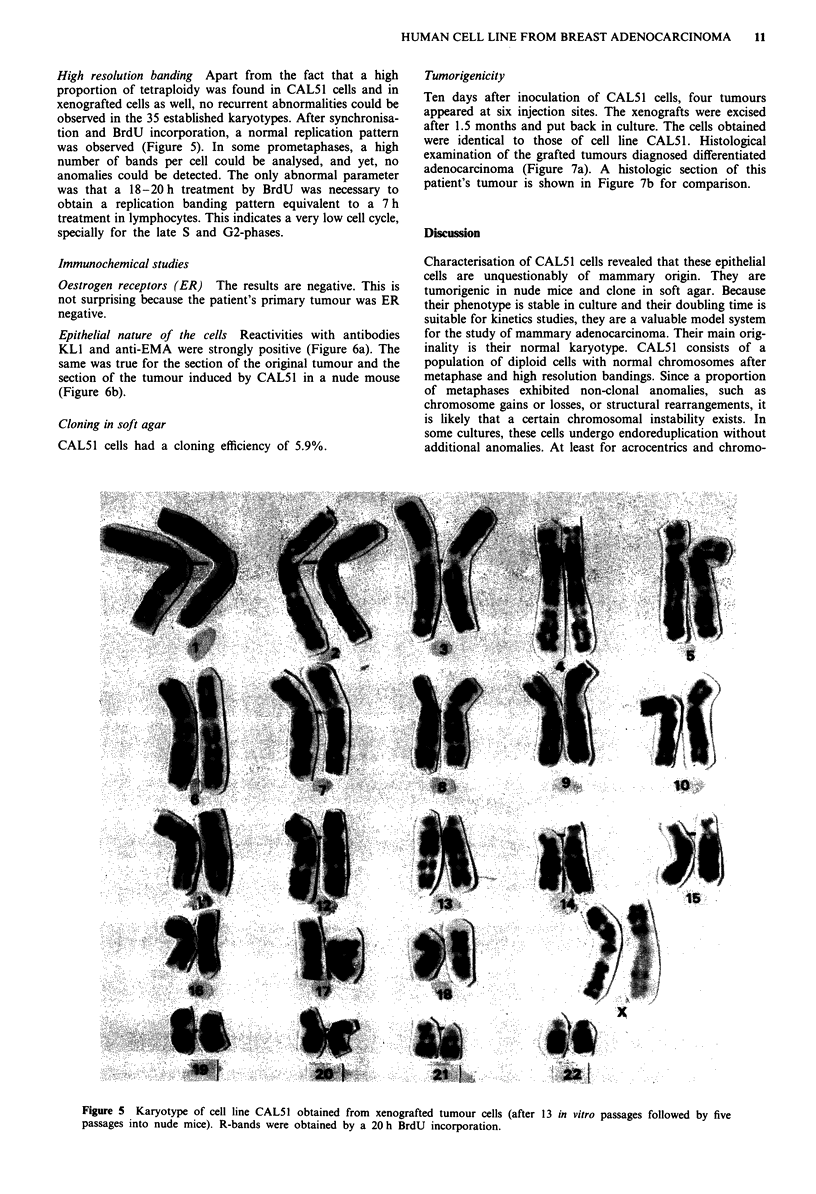
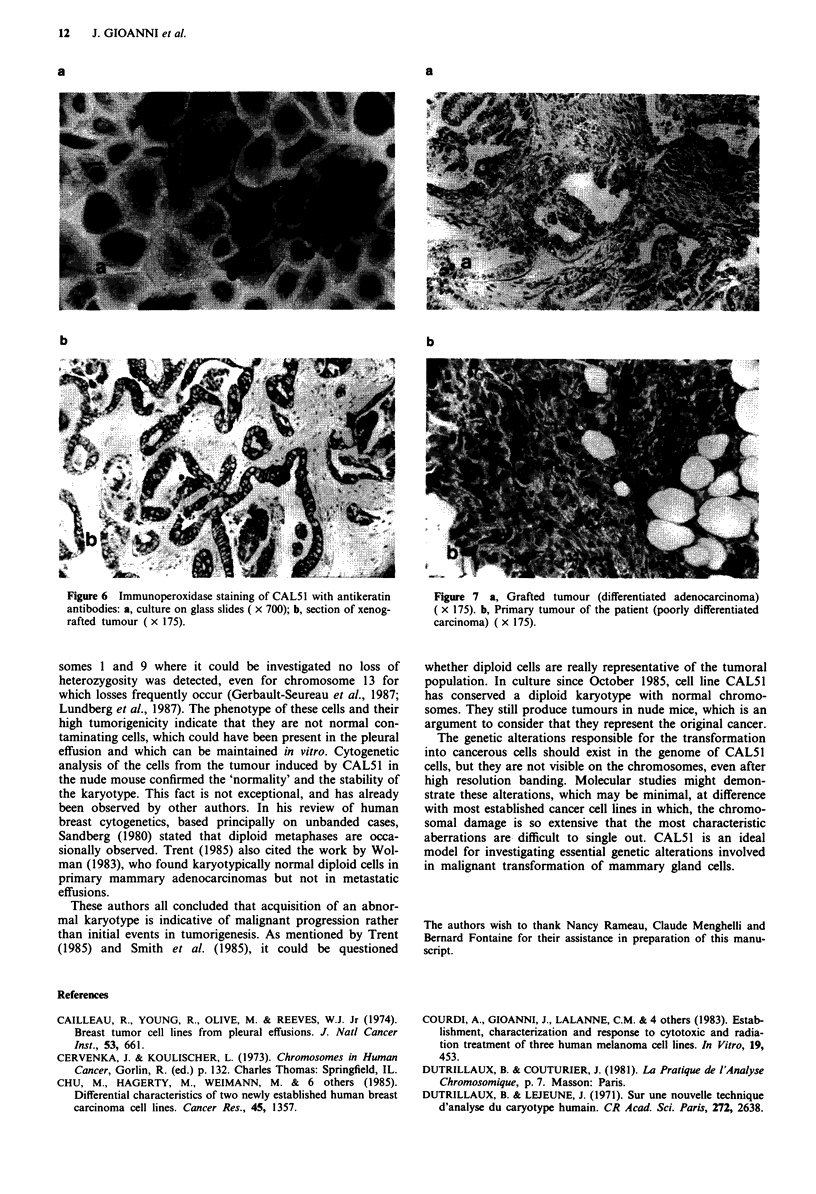
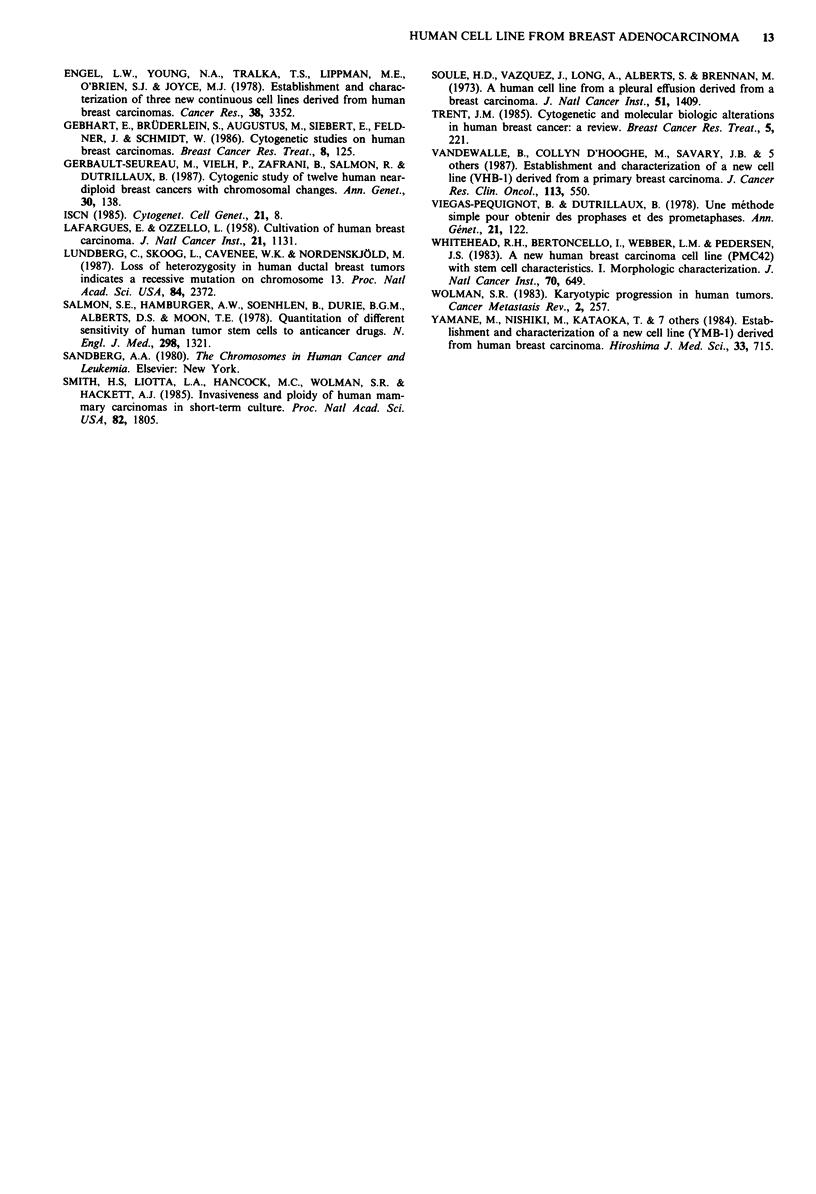
Images in this article
Selected References
These references are in PubMed. This may not be the complete list of references from this article.
- Cailleau R., Young R., Olivé M., Reeves W. J., Jr Breast tumor cell lines from pleural effusions. J Natl Cancer Inst. 1974 Sep;53(3):661–674. doi: 10.1093/jnci/53.3.661. [DOI] [PMC free article] [PubMed] [Google Scholar]
- Chu M. Y., Hagerty M. G., Wiemann M. C., Tibbetts L. M., Sato S., Cummings F. J., Bogaars H. A., Leduc E. H., Calabresi P. Differential characteristics of two newly established human breast carcinoma cell lines. Cancer Res. 1985 Mar;45(3):1357–1366. [PubMed] [Google Scholar]
- Courdi A., Gioanni J., Lalanne C. M., Fischel J. L., Schneider M., Ettore F., Lambert J. C. Establishment, characterization, and response to cytotoxic and radiation treatment of three human melanoma cell lines. In Vitro. 1983 Jun;19(6):453–461. doi: 10.1007/BF02619592. [DOI] [PubMed] [Google Scholar]
- Dutrillaux B., Lejeune J. Sur une nouvelle technique d'analyse du caryotype humain. C R Acad Sci Hebd Seances Acad Sci D. 1971 May 17;272(20):2638–2640. [PubMed] [Google Scholar]
- Engel L. W., Young N. A., Tralka T. S., Lippman M. E., O'Brien S. J., Joyce M. J. Establishment and characterization of three new continuous cell lines derived from human breast carcinomas. Cancer Res. 1978 Oct;38(10):3352–3364. [PubMed] [Google Scholar]
- Gebhart E., Brüderlein S., Augustus M., Siebert E., Feldner J., Schmidt W. Cytogenetic studies on human breast carcinomas. Breast Cancer Res Treat. 1986;8(2):125–138. doi: 10.1007/BF01807701. [DOI] [PubMed] [Google Scholar]
- Gerbault-Seureau M., Vielh P., Zafrani B., Salmon R., Dutrillaux B. Cytogenetic study of twelve human near-diploid breast cancers with chromosomal changes. Ann Genet. 1987;30(3):138–145. [PubMed] [Google Scholar]
- LASFARGUES E. Y., OZZELLO L. Cultivation of human breast carcinomas. J Natl Cancer Inst. 1958 Dec;21(6):1131–1147. [PubMed] [Google Scholar]
- Lundberg C., Skoog L., Cavenee W. K., Nordenskjöld M. Loss of heterozygosity in human ductal breast tumors indicates a recessive mutation on chromosome 13. Proc Natl Acad Sci U S A. 1987 Apr;84(8):2372–2376. doi: 10.1073/pnas.84.8.2372. [DOI] [PMC free article] [PubMed] [Google Scholar]
- Salmon S. E., Hamburger A. W., Soehnlen B., Durie B. G., Alberts D. S., Moon T. E. Quantitation of differential sensitivity of human-tumor stem cells to anticancer drugs. N Engl J Med. 1978 Jun 15;298(24):1321–1327. doi: 10.1056/NEJM197806152982401. [DOI] [PubMed] [Google Scholar]
- Smith H. S., Liotta L. A., Hancock M. C., Wolman S. R., Hackett A. J. Invasiveness and ploidy of human mammary carcinomas in short-term culture. Proc Natl Acad Sci U S A. 1985 Mar;82(6):1805–1809. doi: 10.1073/pnas.82.6.1805. [DOI] [PMC free article] [PubMed] [Google Scholar]
- Soule H. D., Vazguez J., Long A., Albert S., Brennan M. A human cell line from a pleural effusion derived from a breast carcinoma. J Natl Cancer Inst. 1973 Nov;51(5):1409–1416. doi: 10.1093/jnci/51.5.1409. [DOI] [PubMed] [Google Scholar]
- Trent J. M. Cytogenetic and molecular biologic alterations in human breast cancer: a review. Breast Cancer Res Treat. 1985;5(3):221–229. doi: 10.1007/BF01806017. [DOI] [PubMed] [Google Scholar]
- Vandewalle B., Collyn d'Hooghe M., Savary J. B., Vilain M. O., Peyrat J. P., Deminatti M., Delobelle-Deroide A., Lefebvre J. Establishment and characterization of a new cell line (VHB-1) derived from a primary breast carcinoma. J Cancer Res Clin Oncol. 1987;113(6):550–558. doi: 10.1007/BF00390864. [DOI] [PubMed] [Google Scholar]
- Whitehead R. H., Bertoncello I., Webber L. M., Pedersen J. S. A new human breast carcinoma cell line (PMC42) with stem cell characteristics. I. Morphologic characterization. J Natl Cancer Inst. 1983 Apr;70(4):649–661. [PubMed] [Google Scholar]
- Wolman S. R. Karyotypic progression in human tumors. Cancer Metastasis Rev. 1983;2(3):257–293. doi: 10.1007/BF00048481. [DOI] [PubMed] [Google Scholar]
- Yamane M., Nishiki M., Kataoka T., Kishi N., Amano K., Nakagawa K., Okumichi T., Naito M., Ito A., Ezaki H. Establishment and characterization of new cell line (YMB-1) derived from human breast carcinoma. Hiroshima J Med Sci. 1984 Dec;33(4):715–720. [PubMed] [Google Scholar]




